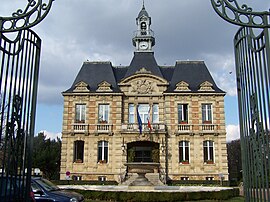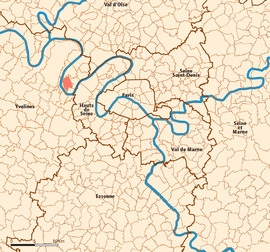Le Vesinet
| Le Vésinet | ||
|---|---|---|

The town hall in Le Vésinet
|
||
|
||
 Location (in red) within Paris inner and outer suburbs |
||
| Coordinates: 48°53′32″N 2°07′59″E / 48.8923°N 2.1331°ECoordinates: 48°53′32″N 2°07′59″E / 48.8923°N 2.1331°E | ||
| Country | France | |
| Region | Île-de-France | |
| Department | Yvelines | |
| Arrondissement | Saint-Germain-en-Laye | |
| Canton | Le Vésinet | |
| Intercommunality | Boucle de la Seine | |
| Area1 | 5.0 km2 (1.9 sq mi) | |
| Population (2009)2 | 16,459 | |
| • Density | 3,300/km2 (8,500/sq mi) | |
| Time zone | CET (UTC+1) | |
| • Summer (DST) | CEST (UTC+2) | |
| INSEE/Postal code | 78650 /78110 | |
| Elevation | 26–47 m (85–154 ft) | |
|
1 French Land Register data, which excludes lakes, ponds, glaciers > 1 km² (0.386 sq mi or 247 acres) and river estuaries. 2Population without double counting: residents of multiple communes (e.g., students and military personnel) only counted once. |
||
1 French Land Register data, which excludes lakes, ponds, glaciers > 1 km² (0.386 sq mi or 247 acres) and river estuaries.
Le Vésinet (pronounced: [lə ve.zi.nɛ]) is a commune in the Yvelines department in the Île-de-France in north-central France. It is located in the western suburbs of Paris, 16.4 km (10.2 mi) from the center of Paris.
Le Vésinet is one of the wealthiest suburbs of Paris, known for its wooded avenues, mansions and lakes. It contains many public gardens designed by French landscape gardener .
The commune of Le Vésinet was created on 31 May 1875 by detaching a part of the territory of Chatou and merging it with a part of the territory of Croissy-sur-Seine and a part of the territory of Le Pecq.
Le Vésinet is located in a bend of the Seine, but has no access to the river. It is 19 km west of Paris and 4 km east of Saint-Germain-en-Laye. The surrounding communes are Chatou on the east, Croissy-sur-Seine on the south, Le Pecq on the west, and Montesson on the north.
The terrain is an alluvial plain ranging from 28 meters near Le Pecq to 45 meters in altitude at the end of the Route de Montesson, with a gentle slope from northeast to southwest.
The commune is entirely urbanized, principally with single-family dwellings. Green space comprises 20 percent of the territory. There are a number of lakes: the lac Supérieur, the lac Inférieur, the lac de la Station, the lac de Croissy, and the Grand lac (with a large central island, l'Île des Ibis) also called Lac des Ibis.. These lakes are linked by nearly 4 km of artificial streams called les Petites Rivières.
...
Wikipedia

